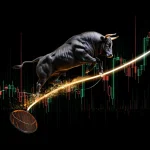
A Sudden Realisation That Shakes Old Beliefs
Dec 26, 2024
Have you ever noticed how some investors seem to thrive during chaos, selling near euphoric peaks and buying when fear grips the market? You might wonder if they possess a secret advantage or a rare gift. Howard Marks, the renowned investor and co-founder of Oaktree Capital Management, suggests that a higher level of thinking—what he calls “second level thinking”—can set these individuals apart. Instead of settling for ordinary assumptions (for instance, “good company equals good investment”), they dig deeper, questioning everything from mass sentiment to the hidden signals in price charts. That approach often leads to choices that feel counterintuitive at the moment yet prove remarkably effective over time.
Reflect on the early 2000s dot-com bubble. A group of forward-thinking investors called the top when everything seemed unstoppable, quietly selling tech shares that had soared beyond reasonable valuations. Meanwhile, euphoric traders justified ever-higher prices by claiming, “This time is different.” A few years later, the cycle repeated before the 2008 housing crash, when banks handed out mortgages without much caution. Again, most participants refused to accept that a reversal was looming. Yet second-level thinkers watched credit indicators, spotted cracks in the buoyant property markets, and acted before the crowd realised something had gone terribly wrong.
These episodes hint that many market participants follow first-level thoughts—buy what is popular, sell what makes headlines for negative reasons—while a minority pursues a deeper examination, searching for possible mispricing. That difference between surface-level interpretation and a more searching mindset has profound implications. Mass psychology often sweeps up casual investors, reinforcing herd instincts. Second-level thinking, however, prods one to question the narrative, ask whether prices have overshot rationality, and hold a firm line when panic sets in. This essay explores how combining Howard Marks’s concept with mass psychology, behavioural quirks, and technical cues can strengthen anyone’s pursuit of market success.
Mass Psychology: How Herd Emotions Crush Logic
Markets revolve around the push and pull of human emotion—excitement, desperation, envy, and greed. When the crowd believes a particular stock or sector is destined for glory, buyers flood in, convinced the trend is bulletproof. First-level thinking might say, “If everyone is buying, I should, too.” Second-level thinking urges a closer look. Are the fundamentals strong, or is this euphoria carried by media hype and social chatter? Could a shift in sentiment send prices tumbling? These questions often reveal gaps in assumptions.
The 2008 housing crash is a textbook demonstration of how mass psychology can distort valuations. Individuals who had never considered real estate speculation suddenly believed that nothing could go wrong. Lenders extended credit freely, trusting continued property appreciation would fix any issues. Buyers stretched themselves, certain that prices would keep climbing. When cracks appeared—foreclosure numbers rising, unmanageable debt burdens—many still ignored the warnings. Eventually, the downturn struck with brutal force, wiping out trillions in wealth.
During such manias, caution sounds dull. Friends share dazzling success stories, and dinner party chatter buzzes with tales of easy gains. Fear of missing out drives participants further. Mass psychology thrives on narratives, and if everyone repeats the same lines about unstoppable growth, it is difficult to stand against popular sentiment. Yet second-level thinkers recognise that once mania becomes too loud, even minor negative news can spark a cascade of selling. Timing that turning point is never simple, but using prudent analysis and looking for extreme sentiment can alert you that a bubble may be ready to burst.
History shows that betting against the familiar story of “things only go up” requires courage. This can mean relinquishing short-term opportunities. You might appear foolish while everyone else watches their portfolios balloon. Then, if your contrarian stance proves right, you have sidestepped a vicious crash or even profited by positioning yourself on the safe side. Observing mass psychology does not mean instant success, but it forms a core element of second-level thinking: stepping away from the herd’s illusions and making decisions grounded in a thorough reading of sentiment.
Behavioural Finance: Digging Beneath Rational Facades
You may imagine that all you need for a winning investment is a sound analysis of earnings statements or macroeconomic data. Yet scholars like Daniel Kahneman have demonstrated that human brains are riddled with biases—recency bias, overconfidence, confirmation bias—that lead us astray. Howard Marks’s second-level thinking involves acknowledging these distortions. Without that awareness, even the brightest investor can be pulled off course by a swarm of misguided signals.
Overconfidence bias ranks high on the list of traps many investors face. Someone sees a string of successful trades and concludes they have a golden touch, amplifying positions just as the market overheats. Another pitfall is confirmation bias, where one hunts for evidence supporting a pre-chosen thesis while ignoring data that contradicts it. Such flaws turn rational strategies into dangerous gambles.
Behavioural finance also highlights the power of loss aversion. Traders tend to hate losses more than they enjoy equivalent gains. When prices decline, investors might hold onto losers, praying for a rebound instead of cutting losses. Or, in the opposite situation, a sudden gain might be cashed out too early to lock in the profit, missing out on further upside. These emotional twists can sabotage good analysis.
Second-level thinking calls for regular self-questioning. Why am I buying this stock? Have I confirmed it is undervalued based on multiple sources, or am I chasing popular opinion? Do I have a plan for exiting if it surges or tanks? This line of inquiry seeks to avoid the lazy assumption that a recent streak of gains guarantees safety. The dot-com frenzy taught a painful lesson: many investors hammered buy orders on worthless dot-com shares, certain that the internet wave would sweep everything higher. They relied on hype rather than fundamentals. Some who studied the underlying finances recoiled long before the crash, recognising that the mania lacked real substance. By anticipating the psychological pitfalls, second-level thinkers refine their approach, aiming to dodge the emotional extremes that plague the market.
Technical Analysis: Searching for Clues Beyond the Headlines
Charts can reveal hints of crowd attitudes before the broader market narrative changes. When combined with second-level thinking, technical signals might confirm suspicions that a rally is running on fumes. Yes, fundamental ratios matter, but so do signs of buying exhaustion embedded in price and volume data. If a stock’s price rockets upward, yet volume remains unimpressive, that divergence may signal that fewer buyers are willing to pay the lofty tag. This can be an early alert of waning bullish pressure.
Likewise, momentum gauges like the Relative Strength Index (RSI) can help spot when an asset has become overbought or oversold. Plenty of times, a market climbs well into overbought regions yet continues rising. First-level observers might say, “RSI is high, so I’ll sell now.” Second-level thinkers probe deeper, watching for additional signs of a serious peak. For instance, volume might surge on negative days, or a leading stock in the same sector might begin to underperform. These layered details can shape stronger decisions rather than relying on a single piece of data.
Consider the housing crash once more. Technical watchers noticed real estate ETFs and related bank shares lagging the overall market. The charts flashed caution signals months before the fiasco became front-page news. Subtle signs of distribution days in financial companies exposed a shift in sentiment. Even if fundamentals still pointed to healthy employment and decent earnings, the technical patterns suggested a hidden quake. When the broader market finally caught up, those early signals turned out to be accurate warnings.
A purely chart-based mindset can also fail if you overlook bigger truths or get blinded by short-term moves. Howard Marks warns that second-level thinking cannot rely on superficial cues alone. Instead, technical analysis should mesh with understanding behavioural distortions and the mania or fear swirling around a certain asset. If you see what appears to be a classic topping pattern while mainstream opinion remains excessively optimistic, it might be time to protect profits. If the opposite occurs—headlines are brutal, but charts hint at bottoming processes—then a brave contrarian purchase might pay off. In both scenarios, the deeper viewpoint helps you interpret chart signals in the broader scheme of human sentiment.
Timing Peaks and Troughs: A Deft Balance
Everyone knows the saying, “Time in the market beats timing the market.” True enough, daily attempts to catch micro-swings often do more harm than good. Yet powerful buying or selling decisions at major turning points can preserve fortunes or secure enormous gains. Second-level thinking points you towards careful action during the extremes of euphoria or panic. It is not about day-trading a random pattern; rather, it involves recognising when the popular mood has diverged so far from logical valuations that a reversal looks likely.
The dot-com collapse exemplifies how this might play out. In late 1999, investors gleefully poured money into untested tech ventures. The Nasdaq soared, and caution was widely mocked. A contrarian might have observed eye-watering valuations, negative earnings, and a frothy mania. Selling at that moment would have seemed premature if you only looked at rising stock prices. Yet second-level thinking demanded an examination of how inflated the stories around these companies had become. Thus, those who quietly reduced exposure missed the final phase of the bubble but avoided the brutal crash that wiped out half or more of many portfolios.
Likewise, the 2009 rebound from the financial crisis showed that contrarian buying in dire times can be rewarding. While headlines were grim—trigger words like “meltdown” and “historic crash” dominated—some noticed bargain valuations and certain technical signs of capitulation. Howard Marks emphasises that making a move against the dominant trend requires both discipline and a willingness to accept that you might look foolish temporarily. If you had purchased shares in the thick of that panic, you would have benefited enormously when the market ultimately recovered.
Of course, no strategy is foolproof. You might sell too early or buy too soon. Second-level thinking combines data, psychology, and a readiness to act differently from the crowd to reduce the likelihood of wild misjudgments. The real secret is not timing every minor correction but spotting the turning points when the masses forget that bull runs do not last forever and crashes often contain seeds of opportunity.
Shaping an Approach That Goes Beyond Ordinary Methods
How might an investor integrate Howard Marks’s second-level thinking into daily practice? The first step is to question each assumption. If everybody else hails a particular software company as the next unstoppable giant, ask why. Do the earnings support that tale, or is the chatter driven by excitement rather than genuine demand? If the share price leaps day after day, watch volume and price patterns for signs of exhaustion. Keep a record of your reasons for buying or selling, then revisit them regularly to see if they have changed.
Building a risk management system can protect against the pitfalls of emotional whipsaws. That might include setting a trailing stop to preserve gains in a soared stock or paying attention to a key chart average to confirm that the broader trend has not turned. During bull phases, second-level thinking reminds you not to get carried away by illusions. During bear markets, it highlights that negative sentiment often overshoots. There is a middle path that acknowledges real data but is sceptical about herd behaviour.
Another valuable tool is open-minded reading. Instead of confining yourself to commentary that supports your viewpoint, balance it with sources that challenge your stance. This can help neutralise biases. If you see an asset receiving universal praise, search for the opposing argument and dissect it. By doing so, you increase the odds of spotting hype or cracks that the mainstream might have dismissed. On the other side, if the entire market despises a sector, check if the gloom is overdone. You might discover a bargain hidden under the wreckage, especially if fundamentals do not confirm the apocalyptic headlines.
Above all, second-level thinking demands patience and self-control. Panicked selling or overconfident buying usually marks a failure to incorporate this concept. Sitting on cash while others chase overvalued assets can be uncomfortable, especially if your peers boast of big short-term triumphs. Yet the discipline to wait often separates consistent winners from those who ride the roller coaster of hype and despair. Following the crowd can feel safe until it suddenly is not, so stepping back to evaluate from multiple angles shows real strength.
Bringing Psychology, Charts, and Contrarian Moves Together
Investing in success rarely flows from studying one aspect in isolation. Behavioural quirks, mass psychology, and technical patterns interlock in complex ways. Yet second-level thinking asks you to piece them together. For instance, if the new market darling has soared 200 per cent in six months, with everyone praising its unstoppable rise, check both the profit statements (to confirm if the euphoria is justified) and the technical readings (to see if the buying frenzy is stretched). Then, reflect on typical behaviour patterns: might investors be giving in to fear of missing out, ignoring signals that a downturn is near?
This triple-pronged method also matters when gloom dominates. Look at the dot-com aftermath in 2002 or the financial crisis of 2009. The general tone was despair, with many convinced that stocks were broken forever. A second-level thinker would notice that certain balance sheets remained healthy, consider whether the RSI or moving averages hinted at a washout, and remember that widespread pessimism can produce bargains. Although buying too early might add some bruises, timing a purchase close to the point of maximum fear can lock in excellent gains.
Howard Marks often speaks of the “price for risk.” If the risk of an asset is accounted for in its price, it might still be a sensible bet. But if the mass mindset is too rosy, then the downside is understated. Similarly, if panic has dragged an asset price far below any rational measure, the upside may outweigh the risk. Judging these scenarios demands a willingness to look past headlines, rely on your own calculations, and keep emotional impulses in check. It is about bridging rational analysis with emotional understanding, spotting when the crowd has lost touch with measured thought.
In weaving these strands—psychology, behavioural principles, and chart signals—second-level thinking stands out as a guiding principle for those aiming to avoid herd errors. It is not an instant recipe for success. It calls for research, self-awareness, and at times, defying the majority. But over multiple market cycles, that readiness to see round corners and recognise flawed group beliefs can pay off with both monetary gains and the satisfaction of knowing you were not led astray by partial logic.
Conclusion: A Call to Embrace Deeper Thought
Does Howard Marks’s notion of second-level thinking truly serve as a secret weapon to outsmart the market? Perhaps “secret” is not the right word since his theories are openly discussed. Yet many remain reluctant to break from the group. It is easier—and more comfortable—to agree with popular wisdom, ride a rising wave, and hope for the best. That strategy can work until the day it abruptly fails, as seen in countless bubbles and busts throughout financial history. The dot-com and housing meltdowns are just two cautionary tales among many.
The alternative path is to question everything. Seek out hidden risks when the crowd celebrates. Look for hidden opportunities when the masses despair. Scrutinise charts to spot cracks in seemingly unstoppable trends and watch for subtle signals of capitulation among battered assets. Never forget the human element—herd instincts and psychological frailties often distort fair values in either direction. By engaging with second-level thought, an investor balances rational analysis with the reality of how fear, greed, and overconfidence sway the masses.
None of this guarantees perfection. You might endure a painful stretch waiting for the market to align with your assessment. Friends might call you cautious or contrarian for missing a sizzling rally. But if your process is consistent and you adjust as fresh data emerges, you stand a better chance of sidestepping catastrophic mistakes that savage many portfolios. Also, you become poised to deploy capital during moments of maximum pessimism.
Ultimately, second-level thinking stands as a reminder that it is not enough to say, “This is a good company” or “Everyone else is buying.” You must look deeper, separating emotional noise from tangible facts, and refusing to surrender to mass euphoria or terror. That mindset can help you remain a step ahead, preserving gains when the music stops and capturing bargains when the crowd’s panic hits extreme levels. In that sense, Howard Marks’s advice does not just promise a bigger balance sheet—it offers a calmer, more deliberate way to approach an uncertain market, giving you the confidence to stand apart from the chaos and outsmart it on your own terms.












